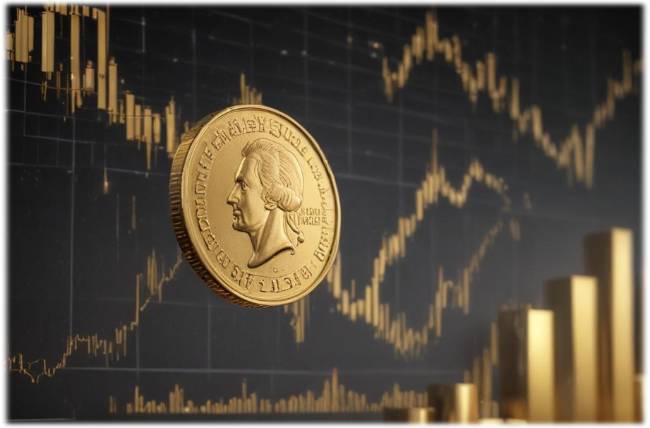Gold’s Enduring Value Amid Market Volatility
Disclaimer: This article is for informational purposes only and does not constitute financial, investment, or legal advice. Consult a qualified professional before making any financial decisions.
By Doug Young – 12 July 2025
Introduction
In an era marked by frequent economic uncertainty and heightened market volatility, the question of which assets provide reliable protection remains critical.
Among these, gold has long been recognized as a safe haven—a financial refuge during times of crisis.
What Is a Safe Haven Asset?
A safe haven asset is defined as an investment that maintains or increases its value during periods of economic downturn or market stress. These assets typically exhibit low or negative correlation with broader markets, meaning they often move independently or inversely to riskier investments like stocks.
Common examples include government bonds, certain currencies, defensive stocks, and precious metals such as gold. The primary appeal of safe haven assets lies in their ability to protect capital when other investments falter, aiding portfolio diversification and risk mitigation.
It is important to understand that safe havens are not necessarily growth assets; their main function is preservation and stability during turbulent times.
Historical Context: Gold’s Role Through the Ages
Gold’s status as a store of value spans thousands of years. Ancient civilizations prized gold for its rarity and beauty, and it served as the foundation of monetary systems for centuries.
During the era of the gold standard, it provided a direct link between currency and tangible wealth, contributing to economic stability. After the gold standard’s end in 1971, gold transitioned into a free-floating asset but retained its role as a hedge against inflation and currency devaluation.
Historically, gold has preserved purchasing power through multiple crises:
- The Great Depression, when banks failed and currencies lost value, gold maintained its worth.
- The 1970s inflation crisis, when gold prices surged over 2,000% amid high inflation and geopolitical turmoil.
- The 2008 Global Financial Crisis, when gold rose approximately 20% as investors sought safety.
- The 2020 COVID-19 pandemic, when despite initial volatility, gold reached record highs as economic uncertainty intensified.
These episodes illustrate gold’s resilience and its ability to act as a financial refuge.
Characteristics That Make Gold a Safe Haven
Several intrinsic qualities underpin gold’s reputation as a safe haven:
- Intrinsic value and scarcity—unlike fiat currencies, gold cannot be created arbitrarily.
- Its limited supply protects against devaluation and inflation.
- Low correlation with other assets—gold often moves independently of stocks and bonds, providing diversification benefits.
- Global liquidity—gold is highly liquid worldwide, allowing holders to convert it into cash quickly during crises.
- Geopolitical neutrality—gold is not tied to any specific government or currency, making it immune to political risk.
- Durability and tangibility—as a physical asset, gold does not degrade and can be stored securely outside the financial system.
These features collectively contribute to gold’s ability to preserve wealth when other assets falter.
Gold’s Performance During Market Volatility: Nuances and Realities
While gold is widely regarded as a safe haven, its performance during crises is nuanced. For example, during the March 2020 market crash triggered by the COVID-19 pandemic, gold prices initially fell alongside equities due to widespread liquidity needs.
This illustrates that in extreme market stress, gold may be sold to cover losses elsewhere, temporarily undermining its safe haven status. Research indicates that gold’s safe haven effect tends to be strongest during periods of extreme negative returns but may last only short durations, often around two to three weeks.
Therefore, gold is better understood as a long-term store of value and portfolio diversifier rather than a perfect short-term hedge.
Central Banks and Institutional Demand for Gold
Central banks globally have been increasing their gold reserves in recent years, signaling confidence in gold’s role as a strategic asset.
This accumulation serves to diversify reserves away from fiat currencies, particularly the U.S. dollar, and to protect national wealth from systemic monetary risks.
Such institutional demand reinforces gold’s status as a trusted asset in the global financial system, underscoring its importance beyond individual investors.
Gold and Inflation Protection
Inflation erodes the purchasing power of fiat currencies, prompting investors to seek assets that preserve value.
Historically, gold has served as an effective inflation hedge over the long term. While gold prices may not track inflation precisely in the short term, its value tends to rise during prolonged inflationary periods.
This characteristic makes gold a tool for maintaining real wealth, especially when monetary policy leads to currency debasement.
Comparing Gold to Other Safe Haven Assets
Feature Gold Government Bonds Defensive Stocks Other Alternatives Inflation Hedge Strong over long term Moderate Low Varies Liquidity Very high High Moderate Varies Correlation with Stocks Low Often inverse Moderate to high Varies Counterparty Risk None (physical asset) Yes (issuer risk) Yes Varies Historical Stability Thousands of years Decades Decades Varies This comparison highlights gold’s unique combination of features that contribute to its enduring appeal as a safe haven.
Practical Considerations for Understanding Gold’s Role
Understanding gold’s role requires recognizing it as a monetary asset rather than a growth investment. It typically does not generate income or dividends and can experience price volatility. Its primary function is capital preservation and risk reduction during times of uncertainty.
Separating emotional reactions from historical facts is essential when considering gold’s place in a financial context. Gold’s value lies in its resilience and reliability, not in short-term price gains.
Conclusion
Gold’s enduring value amid market volatility stems from its unique characteristics, historical resilience, and role within the global monetary system.
While it may not always rise during every crisis, gold remains a critical tool for preserving wealth and managing risk over the long term.
Understanding gold’s nuanced behavior and historical context is key to appreciating its continuing relevance in today’s complex financial landscape.
Disclaimer: This article is for informational purposes only and does not constitute financial, investment, or legal advice. Consult a qualified professional before making any financial decisions.









